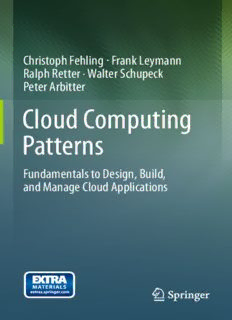
Cloud Computing Patterns; Fundamentals to Design, Build, and Manage Cloud Applications - Springer PDF
Preview Cloud Computing Patterns; Fundamentals to Design, Build, and Manage Cloud Applications - Springer
Christoph Fehling Frank Leymann Ralph Retter · Walter Schupeck Peter Arbitter Cloud Computing Patterns Fundamentals to Design, Build, and Manage Cloud Applications Cloud Computing Patterns . Christoph Fehling (cid:129) Frank Leymann (cid:129) Ralph Retter (cid:129) Walter Schupeck (cid:129) Peter Arbitter Cloud Computing Patterns Fundamentals to Design, Build, and Manage Cloud Applications ChristophFehling FrankLeymann UniversityofStuttgart UniversityofStuttgart Stuttgart Stuttgart Germany Germany RalphRetter WalterSchupeck T-SystemsInternationalGmbH DaimlerAG Frankfurt Stuttgart Germany Germany Peter Arbitter Microsoft Deutschland GmbH Unterschleißheim Germany ThefiguresandiconsarenotsubjecttoSpringer’scopyright.Pleasecontacttheauthorsin caseofanyquestionsorrequestsforpermission. Additionalmaterialtothisbookcanbedownloadedfromhttp://extra.springer.com. ISBN978-3-7091-1567-1 ISBN978-3-7091-1568-8(eBook) DOI10.1007/978-3-7091-1568-8 SpringerWienHeidelbergNewYorkDordrechtLondon LibraryofCongressControlNumber:2013955000 #Springer-VerlagWien2014 Thisworkissubjecttocopyright.AllrightsarereservedbythePublisher,whetherthewholeorpartof the material is concerned, specifically the rights of translation, reprinting, reuse of illustrations, recitation,broadcasting,reproductiononmicrofilmsorinanyotherphysicalway,andtransmissionor informationstorageandretrieval,electronicadaptation,computersoftware,orbysimilarordissimilar methodologynowknownorhereafterdeveloped.Exemptedfromthislegalreservationarebriefexcerpts inconnectionwithreviewsorscholarlyanalysisormaterialsuppliedspecificallyforthepurposeofbeing enteredandexecutedonacomputersystem,forexclusiveusebythepurchaserofthework.Duplication ofthispublicationorpartsthereofispermittedonlyundertheprovisionsoftheCopyrightLawofthe Publisher’s location, in its current version, and permission for use must always be obtained from Springer.PermissionsforusemaybeobtainedthroughRightsLinkattheCopyrightClearanceCenter. ViolationsareliabletoprosecutionundertherespectiveCopyrightLaw. The use of general descriptive names, registered names, trademarks, service marks, etc. in this publicationdoesnotimply,evenintheabsenceofaspecificstatement,thatsuchnamesareexempt fromtherelevantprotectivelawsandregulationsandthereforefreeforgeneraluse. While the advice and information in this book are believed to be true and accurate at the date of publication,neithertheauthorsnortheeditorsnorthepublishercanacceptanylegalresponsibilityfor anyerrorsoromissionsthatmaybemade.Thepublishermakesnowarranty,expressorimplied,with respecttothematerialcontainedherein. Printedonacid-freepaper SpringerispartofSpringerScience+BusinessMedia(www.springer.com) To Carina and my parents, Elisabeth and Horst. Thankyouforyourloveandsupport. – Christoph To the woman of my dreams! – Frank To Anni and Emil. – Ralph To my grandsons Leonardo and Max Viktor. – Walter ToAnnika,Paulina,Nils,andmylovelywife Martina. – Peter . Foreword by Gregor Hohpe Overtherecentyears,youmayhaveobservedastrategy,dareIsay“pattern,”for software engineering books: take a popular buzzword and append the word “patterns” to suggest that this particular title contains a substantial treatment of thesubjectmatterandisorganizedasacollectionofeasytodigestchapters,which promisetoprovidesolutionstorecurringproblems.Forthepatterncommunity,this isadefinitesignofsuccess,andnotonethatisduetolargemarketingbudgetsbut rather manysuccessfultitles thatdeliveronthisverypromise.Arecent search on the “world’s largest bookstore”inthe category “Books –Software Development” yieldednolessthan499titlescontainingtheword“patterns.”Howdoesonepick outthegemsfromsuchavastcollectionofsolutionstorecurringproblems? First, good patterns books present a coherent pattern language, not just a collectionofpatterns,inlinewithChristopherAlexander’sseminaltitleAPattern Language.Structuringapileofpatternsintoasequenceofchaptersislaudablebut doesnotmakealanguage.Rather,apatternlanguagecoversaspecificdomainand usually offers multiple patterns for common design challenges and offers a clear roadmapthroughthepatterns. Many influential software patterns books have also adopted a strong visual language.ImaybebiasedbecauseEnterpriseIntegrationPatternswasoneofthe first titles to expand the notion of a pattern sketch to a visually coherent iconic language,butbecausesoftwarearchitectureandspecificallysoftwarepatternsaim tocommunicatecomplexdesignideasinaneasy-to-graspway,avisuallanguageis astrongasset. Almost all significant software patterns books are not simply the result of the authors’ deep insight or determination but have been a true community effort. For example, the Pattern Languages of Programming (PLoP) conference, which hasbeenrunningsince1994,hasbeenthebirthplaceofmanygreatpatternsbooks. Whileitiscertainlynotarequirementforpatternauthorstoworkshoptheirpapers at PLoP, the claim that patterns are harvested rather than invented points to the importance of community participation. This also means that good patterns booksdon’tusuallypopoutofnowherebutarethepinnacleofalengthyprocessof stepwiserefinementbasedoncommunityfeedback. vii viii ForewordbyGregorHohpe Last but not least, most successful patterns books strike a delicate balance between academic rigor and real-world applications. The academic world brings depthofthinkingandaclearstructure,whiletheindustrycontributestherequired validationandreal-worldexamples. If you are wondering why the foreword to Cloud Computing Patterns muses aboutthepatternmovementasawhole,Iinviteyoutorevisitafterreadingthistitle. IhopeyouwillagreethatIwasinfactdescribingtheessentialpropertiesofcloud computingpatterns!Ihavenotmuchlefttosaybutcongratulatetheauthorsonthe successful delivery of a relevant, well-structured, and community-validated soft- ware patterns title. Because I am sure I won’t have to convince you that cloud computing is one of the most relevant software engineering topics of the last decade. –GregorHohpe,coauthorofEnterpriseIntegrationPatterns(Hohpe,G.,WoolfB.: Enterprise Integration Patterns: Designing, Building, and Deploying Messaging Solutions.Addison-Wesley.http://www.eaipatterns.com/(2003)). GregorHohpe Foreword by Robert Hanmer The forecast for computing is full of clouds. The computer press and the public media are abuzz with “cloud-this” and “cloud-that,” but what does it all mean? Inmanyindustries,serviceprovidersarelookingtothecloudtohelpsimplifytheir hardwaremanagementandincreasetheirflexibilityandadaptabilitytochangeand toprovidenewandinnovativeservices,butmuchofwhat’swrittenaboutcloudsis aboutthenutsandboltsandofferingsofspecificcloudproviders.Thebigpictureof how to build useful and robust applications to support business needs on top of cloudsismissing.Specificcasestudiesareuseful,buttheycanbelimitingbecause theyalsoaretiedtospecifics.What’sneededisaresourcetounderstandtheinsand outsofcloudsandhowtheycanbeusedfromatop-downperspective.Thisbookis thatresource. I first met the authors at the 2011 Pattern Languages of Programming Confer- ence in Portland, OR, USA. They submitted a paper to the conference that was aboutearlyworkthatultimatelyledtothisbook.Becauseapaperaboutcloudswas timely,itwasoneofthemostpopularpapersattheconference.Everyonewantedto learn more about clouds, and all were intrigued by the range of cloud solutions studiedtounderstandthepatterns. PatternsinthestyleofChristopherAlexanderandtheDesignPatternsbook[2] (akatheGangofFour-GOFpatterns)arebasedonreal-lifeexperiencesandproven practices, not unproven theories. The successes, failures, and “aha’s” of real-life solutions were captured in these patterns which were mined from projects across several industries. The authors aren’t trying to sell clouds and they aren’t just patting themselves on the back because they’ve built somethingnice with clouds. Theyexplaincloudsbasedonwhatthey’veseenworkinpractice.Thetopicsrange fromthebasicsofon-demandself-service,broadnetworkaccess,payperuse,and rapidelasticitytocomplextopicslikestructuringmulti-tierapplicationsandhowto besthandleissueslikefaulttoleranceandperformance. Patternsexplainnotjustwhatacloudisorwhatyoumustdotoeffectivelyusea cloudbutalsoexplainthetrade-offsinvolvedinusingthecloud.Thepatternstiethe cloud definitions back to the NIST Definitions of Cloud Computing [3] to thor- oughlycoverthetopic.Iagreewiththeauthorsthatthepatternformisagoodway ix
